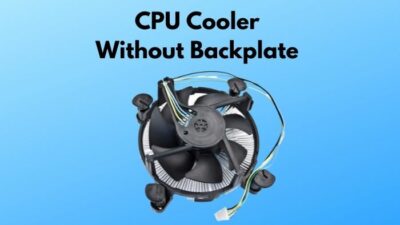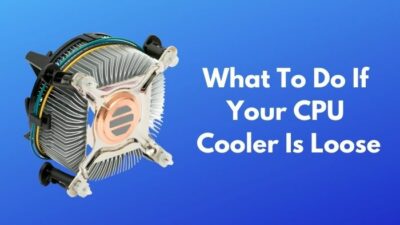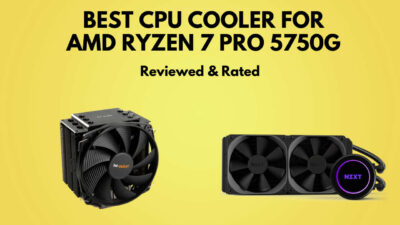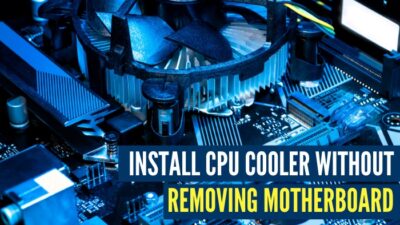A CPU without a cooling system is like using a refrigerator without a condenser. Lacking a condenser fails the intention of a refrigerator. Similarly, the PC won’t even run without a cooler, which is bizarre.
When the processor’s cooler stops working, the chip will overheat & eventually shut down. In severe cases, it can get fried too. So proper maintenance of the CPU cooler is crucial.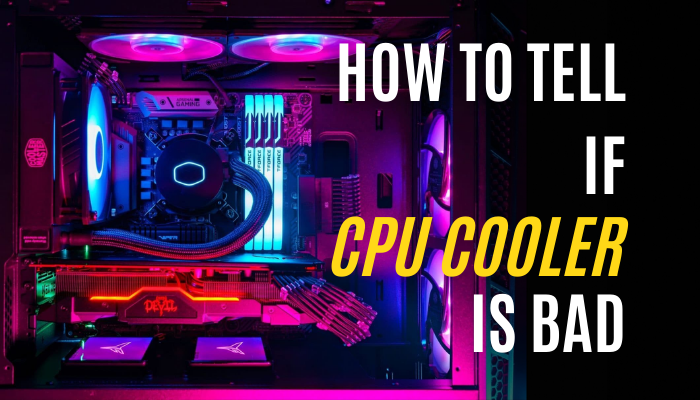
In this article, I will describe how you can identify the cooler status & its importance. Let’s dive in.
How to Check if the CPU Cooler is Defective
Every problem has some symptoms. Similarly, a cooler can show some signs, whether it’s dying or at a critical stage.
The cooler’s fan can make loud noises, the chip can get overheated, and random freezes or shut down, all can indicate a concern about the heating issues. This will result in a slow boot or poor performance in app handling. Furthermore, these symptoms lead to the cooling system.
Before you come to the conclusion that your cooler is faulty, check and make sure the CPU cooler is compatible with your processor and motherboard.
A few months ago, one of my friends cleaned his PC. After cleaning up, he was playing Microsoft Flight Simulator, but he was suddenly facing stutters. He also hears some loud noises from the CPU cooler too.
Later, I told him to check the cooler & he found out it was not mounted properly. This was causing overheating issues & results in lags.
So, how can you tell the processor cooler is unfavorable?
Here are some absolute ways to find out if the CPU cooler is bad:
1. Check Cooler’s Fan Noise
The cooling system’s fan can produce a louder noise & run at max RPM even though there is no heavy load. This can be an indication of a faulty cooler.
You can hear the noise, but a visual number can ensure its authenticity. To check the cooler’s fan speed, you can use BIOS, SpeedFan, HWiNFO, etc.
For BIOS, you can go there with the designated key by your manufacturer motherboard, such as Delete key or F2. For X570 Aorus Master mobo, press the Del key to enter BIOS during boot. In EASY MODE, You will find the CPU fan speed in the Smart Fan section located in the bottom middle.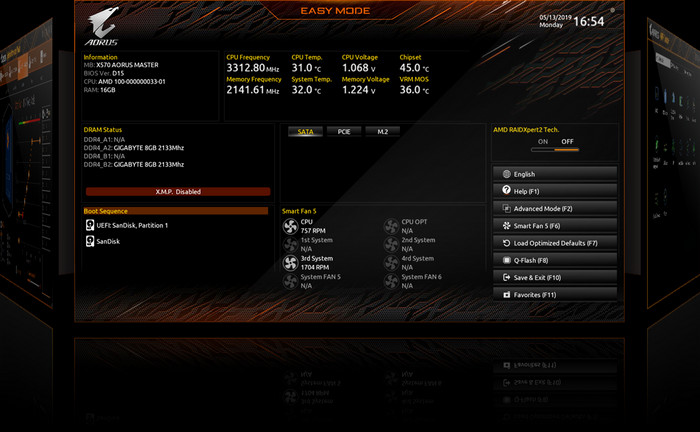
With HWiNFO, you can monitor various hardware sensors.
Follow the steps to check the CPU fan speed with HWiNFO:
- Download the portable version of the software.
- Open it with Sensors-only.
- Scroll down & find your motherboard’s model section.
There you will find CPU fan speed in RPM value along with other system fans.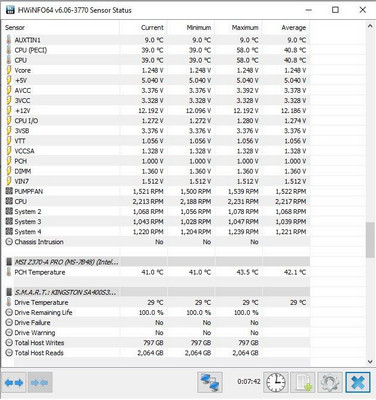
If the fan runs at max frequency, it can be a sign that the fan can’t dissipate the heat for dust or the fan’s bearing is becoming loose.
2. Look for Physical Damage to the Cooler Fan’s Blade
The fan blade can get damaged or broken. If that’s the case, it will not function properly & can’t scatter the heat from the heat sink. This will raise the chip’s temp, which will eventually force the fan to rotate faster. This will lead to failure if you don’t take proper steps quickly.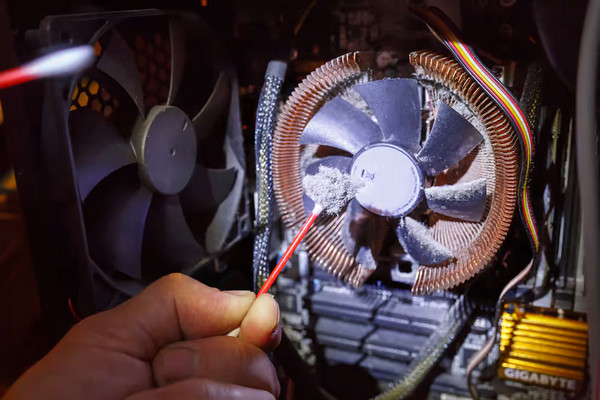
You can open the casing’s side panel, & manually observe if there is any physical problem with the cooling fan. If it gets damaged, you should replace it ASAP.
3. Track Down Processor Temperature
Monitoring hardware temperature on a regular basis is not needed, but keeping an eye on it is crucial. Because a high temp can even fry hardware.
So if you face stutter, frames dropping in games, or a slowdown in productivity work, the first thing you should do is to check the CPU temperature.
To check the temperature, you can use HWiNFO. It’s a popular free software to monitor various sensors.
Here are the steps to check CPU temp with the app:
- Open HWiNFO with Sensors-only.
- Go to your CPU model name’s section.
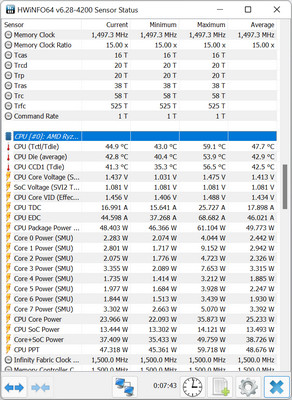
There you will find your CPU temp. If it is too hot & CPU throttles due to overheating, the software will show a red value of the temp. This high temp indicates that the cooler is failing to cool down the CPU & insufficient for the chip.
4. Stress Test the Chip
You can also stress-test the processor to check if the CPU cooler is working correctly. During heavy gaming or stress testing, it puts a hefty load on the chip, causing high usage. This results in high power consumption, which increases the temp.
In this scenario, if the cooling system is enough to handle the heat, it will run fine. However, if the cooler is dying, it will fail to keep the chip in a safe temp range, which can cause catastrophic damage.
5. Inspect the CPU Cooler’s Position
To get a proper view of the cooler’s installation, it is better to move out the motherboard from the casing. So that you will check out the cooler’s position & make sure the CPU cooler is seated properly.
Here are the steps to verify a cooler’s placement:
- Open casing’s side panel.
- Unscrew the motherboard’s screw from the casing carefully.
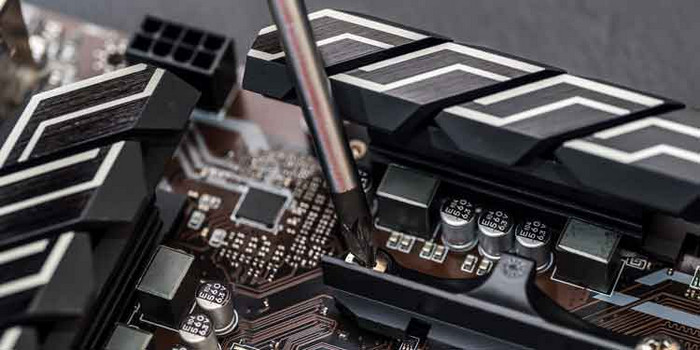
- Take out the motherboard from the casing with caution.
- Check if all the clips or screws of the cooler are tightened properly.
- Inspect if the heat sink is seated evenly & properly attached to the CPU.
Now, you know how to identify whether a cooling system is bad or not. It’s time to save some hassle by servicing the cooler before it gets defective. To learn more, read ahead.
How to Maintain the CPU Cooler
Maintaining the cooling system is essential to get the performance from the cooler up to the mark. As there are Air CPU coolers, AIO coolers & Custom water loop coolers, you need to know the differences.
Air CPU coolers are very easy to install & maintain. This type of cooler usually consists of a heat sink & one/two fans. To maintain this type of cooler, you just need to clear the fan & remove dust from the heat sink. If the fan breaks, all you have to do is change the fan to a new one.
AIO coolers are better capable of cooling down the chip than air coolers. These coolers contain two/three fans, a radiator & a heat sink. You need to clean the fan & radiator to ensure proper airflow.
The custom water loop is the expensive one, but this cools down the components to a great margin too. This requires an expert hand to properly maintain, because any leak of the liquid can damage your whole computer parts inside the casing. Making sure the pump is running ok & there is no leakage in the pipe is the priority for this type of cooler.
How Long Does a Cooler Fan Last? What Happens to Your PC Then?
If you don’t maintain your cooler properly, likely as mentioned above, your cooling system will not work to its full potential. If you use an old cooler, the lifespan of your cooler fan will also expire.
So if a CPU cooler fan dies, you will face immediate overheating. If you realize the CPU fan dies, you should immediately turn off your PC.
Though Intel & AMD CPUs have safeguard mechanisms, which will start to throttle down the frequency to reduce temp & if that doesn’t work, it will shut down the system. During the next boot, it will also show CPU Overheat Temperature Error.
So, how long does a cooler fan generally last?
Well, depending on the quality of the fan, the fan can last 4 to 5 years without problem & with some proper maintenance. The heat sink can survive many years if it doesn’t get dirty with dust or build up rust.
How to Pick a CPU Cooler
If you are reading this, assuming your cooler is dead or not working up to the performance. So to buy a new CPU cooler, you need to keep some criteria in your head.
Here are some important aspects you must follow before buying a new CPU cooler:
- TDP of CPU: Every processor comes with a TDP value, which is Thermal Design Power. This indicates how much heat the chip spreads. So before buying a new CPU cooler, it’s a must to check the cooler’s ability, whether it’s capable or not, for the particular CPU you have.
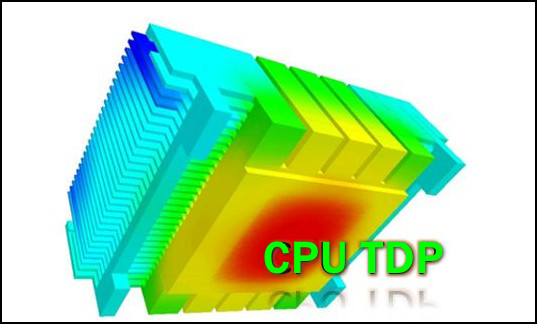
- Casing Clearance: For every casing specification, they mention the CPU cooler’s clearance. A cooler with a 120 mm fan usually needs 160 mm clearance. So make sure you have enough side clearance in the casing. Otherwise, you have to go for a 90 mm fan, which may not be adequate for your CPU, or you may have to choose another option, such as an AIO cooler.
- RAM Clearance: RAM clearance is another issue you must check before buying a new air cooler. Some air coolers come with 3 fans with dual heat sinks. This takes up a lot of space, which may conflict with your RAM.

- Size of the Cooler: The cooler size also affects performance. A tower air cooler is more capable of cooling down than a mid-tower cooler. So depending on your need, you need to pick the right size.
- Motherboard Sockets Compatible: As Newer generation chips come with newer sockets, mainboards sometimes change the cooler’s bracket support. So, whether a cooler is properly compatible with the motherboard is very important.
In case you are wondering what coolers to go with, check out the list of best CPU coolers and AIO coolers you can buy right now. And yes, RGB options are also included.
FAQs
Do you require an expensive cooler?
Being expensive doesn’t always mean good quality. Sometimes adding useless aesthetics make products expensive; however, they compromise the quality. A good quality air cooler will support you more than a bad quality AIO. You need to make sure to choose an adequate cooler for your CPU.
Can CPU coolers break?
If you buy a tower-sized air cooler with 3 fans & don’t properly screw with the motherboard, it can bend or possibly break the mobo.
What are the disadvantages of Liquid Coolers?
The main cons of the liquid cooler are: it is more expensive, requires expert hands to install, and the possibility of liquid leakage.
Final Thought
A CPU cooler is an adjacent part of the CPU. Without the cooler, the system will not boot, & even if it boots, it will shut down within a minute.Excessive heat can’t be controlled without a properly working cooler. So knowing the condition of the cooler is significant for day-to-day usage. Also, proper maintenance of the cooling system is also vital.
In this article, I explained how you can identify the indications of a bad processor cooler. You will also find some fundamental criteria to look out for when purchasing a new cooler. If you have any further queries, don’t hesitate to come back & leave a comment.

